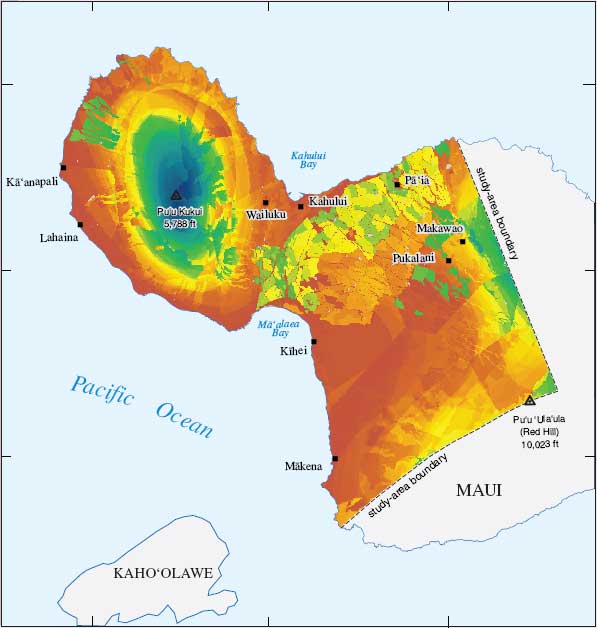Pacific Islands Water Science Center

Relative distribution of estimated ground-water recharge during 2000-04 in central and west Maui, Hawai‘i. Estimated recharge is shown using a color scale with red representing lowest recharge and violet representing highest recharge.
Concern surrounding declines in ground-water levels and an increase in the chloride concentration of water pumped from wells in the ‘Īao aquifer system on the Island of Maui has prompted an investigation into the long-term sustainability of current (2006) and future ground-water withdrawals. As part of this investigation, a water budget for central and west Maui was calculated from which (1) ground-water recharge was estimated for the period 1926-2004 and (2) the effects of agricultural land-use changes and drought were analyzed.
Estimated mean ground-water recharge decreased 44 percent from 1979 to 2004 in central and west Maui. Reduction in agricultural irrigation, resulting from more efficient irrigation methods and a reduction in the acreage used for agriculture, is largely responsible for the declining recharge. Recently, periods of lower-than-average rainfall have further reduced recharge. During the period 1926-79, ground-water recharge averaged 693 Mgal/d, irrigation averaged 437 Mgal/d, and rainfall averaged 897 Mgal/d. During the period 2000-04, ground-water recharge averaged 391 Mgal/d, irrigation averaged 237 Mgal/d, and rainfall averaged 796 Mgal/d.
Simulations of hypothetical future conditions indicate that a cessation of agriculture in central and west Maui would reduce mean ground-water recharge by 18 percent in comparison with current conditions, assuming that current climatic conditions are the same as the long-term-average conditions during the period 1926-2004. A period of drought identical to that of 1998-2002 would reduce mean recharge by 27 percent. Mean recharge would decrease by 46 percent if this drought were to occur after a cessation of agriculture in central and western Maui. Whereas droughts are transient phenomena, a reduction in agricultural irrigation is likely a permanent condition.
Download this report as an 69-page PDF file (sir2007-5103.pdf; 9.8 MB)
Suggested citation and version history
For questions about the content of this report, contact John A. EngottDownload a free copy of the current version of Adobe Reader.
| Help
| PDF help
| Publications main page | Western Scientific Investigations Reports |
| Water Resources | Pacific Islands Water Science Center
|
This report is also available only on the Web